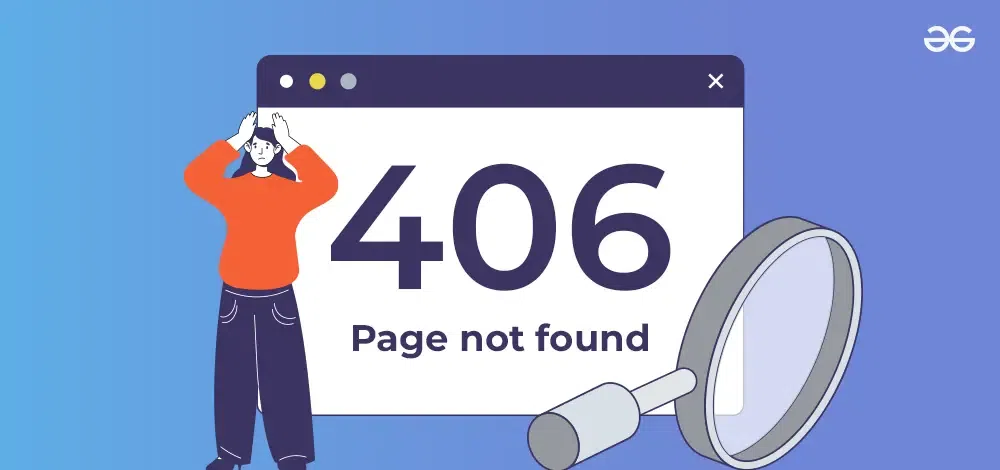
|
|
We often encounter errors while browsing the web. One such common error is HTTP 406: Not Acceptable Error. Essentially, it signals that the server is unable to generate a response that aligns with the acceptable values mentioned in the headers of the client’s request. Generally, this error arises when the server faces challenges in delivering content that meets the specific criteria set by the client in the Accept header.
This HTTP error code, known as “Not Acceptable,” belongs to the category of client error responses. In this article, we’ll look into what HTTP 406 means, talk about common problems connected to it, and give clear solutions to fix those issues. What is HTTP Error Code 406?The “406 Not Acceptable” error is due to a process known as content negotiation where the client (like a web browser) and the server share details on what types of content they can handle. This information exchange uses HTTP headers, especially the ‘Accept‘ headers, which let the client specify the formats, languages, encodings, and character sets it prefers or can deal with. Now, when the client (web browser) sends a request to the server, it states its content format preferences through these Accept headers. If the server’s response doesn’t match any of these preferences or breaks any specified rules, it throws a 406 error. In short, the server can’t send the response content in the way your browser requested it. Issues due to HTTP Error Code 406Getting an HTTP 406 error can lead to various issues for users and website admins. The error, commonly known as “not acceptable, results in lots of problems. Key issues
Causes of HTTP Error Code 4061. Mismatched Content TypesThe 406 error happens when the things our browser wants to see on a website (like certain types of pictures, maybe in jpeg format or something else, or text), as specified in the header, don’t match with what the server can actually show. This mismatch results in the server being unable to generate an acceptable response. 2. Unsupported Character Sets or EncodingsIf the client requests content with specific character sets or encodings and the server lacks the capability to furnish content in those requested formats, the 406 error is triggered. 3. Incomplete or incorrect headersInaccurate or incomplete headers in the client’s request can lead to a breakdown in communication. The server may struggle to interpret the client’s expectations, resulting in the generation of a 406 error. 4. Insufficient server configurationThis occurs when the server lacks the necessary configurations to handle requested content types, causing the 406 error. The server may lack the capabilities or configurations to generate content in formats specified by the client. Resolving this involves adjusting server settings to align with expected content types, ensuring a smooth exchange between client and server. 5. MIME Type MistmatchAt times, the browser requests a particular MIME type from the server, which represents content elements like JPEG images, specific video formats, or simple text. If the server can’t give you the kind of file you asked for, like a JPEG image, you’ll see a 406 error. How to Fix HTTP Error Code 406Let us see some of the ways in which we can fix the HTTP Error Code 406. 1. Adjust Request HeadersThe client asking for information tells the server what kind of response it wants through an ‘Accept‘ header (like wanting the answer in HTML, XML, or JSON). If there’s an HTTP Error Code 406, we can solve it by changing the request headers.
2. Server ConfigurationThe server needs to be capable of generating the responses in the formats requested by the client. If you are getting the HTTP Error 406, then one possible reason could be server configuration. You can fix the error in the following ways:.
3. Content NegotiationContent negotiation is like a conversation between the client and the server. They talk to each other and decide on the best way to share information, like choosing the right format for the response. The error 406 could be fixed by:
4.Error HandlingImproving the error messages can help the developer understand the root cause of the issue and resolve it more efficiently. To fix the error 406, we can use the following error handling methods:
5. Update client libraries or frameworks.The client-side codebase may have outdated libraries, or it must have used obsolete frameworks that result in its inability to handle a wide range of response formats. The potential solutions to this issue are:
6. Provide a default response format.To prevent errors when the client’s preferred format is unavailable, offer a default response format that is widely supported. To address this, the server can be configured to have a default response format that is widely supported, such as JSON or HTML. Here is how it can be implemented:
ConclusionGetting the HTTP Error Code 406 indicates a mismatch between client expectations and server capabilities. This issue, known as “Not Acceptable,” can downgrade content delivery, causing user frustration and impacting engagement with the website. To resolve this, adjusting request headers, ensuring server compatibility, and implementing content negotiation mechanisms are crucial. Moreover, effective error handling and updating client-side libraries and frameworks can contribute to a smoother user experience. Providing a default response format enhances resilience, preventing 406 errors. These steps collectively address challenges and promote seamless interaction between clients and servers in web environments. FAQs on What is 406 Status Code? Issues, and How to Fix Them?What does HTTP Error Code 406 mean?
Why do users and website admins face issues with HTTP 406 errors?
What causes HTTP Error Code 406?
How can HTTP Error Code 406 be fixed?
Why does HTTP Error Code 406 impact user engagement?
|
Reffered: https://www.geeksforgeeks.org
| GBlog |
Type: | Geek |
Category: | Coding |
Sub Category: | Tutorial |
Uploaded by: | Admin |
Views: | 13 |